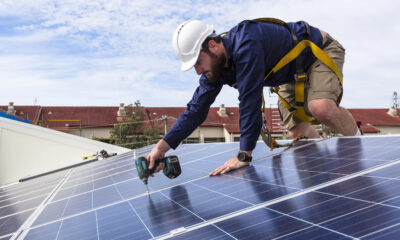

Environment
How to build a green home & what to avoid
Before you begin to build a green home, you need to understand what to avoid and how your choices will impact the future. With an abundance of information about green alternatives for materials and energy saving solutions becoming increasingly available, you need to be considering your carbon footprint during construction.
Modern green approaches to construction have led to the first straw houses going on sale in the UK this year. Due to their resilience and ability to absorb carbon dioxide, the crane rental company Emerson Crane Hire have said that construction materials like timber and straw could one day be the norm.
Whether you are building a new home, seeking out a plot of land to construct your property, or renovating an existing building, here are a few universal tips that ensure you’ll build a green home. And they aren’t difficult to implement.
New builds: find optimum light exposure for solar power
Solar power could save two tonnes of carbon dioxide every year, helping to save your home expenses of a couple of hundred pounds annually. Solar panels, tiles or slates – which vary in cost effectiveness based on location and use – help you to save money while being eco-friendly.
Location is key for solar power. While the myths surrounding solar panels and cloudy days don’t hold up, you can make sure that your solar panels are optimised for your home by getting the most sun exposure.
When building your own home aim for a southern exposure to reduce heat waste and consult with your architect about building in solar power systems.
Existing houses: update insulation & watch out for asbestos
If your house was built before the late 1990s then it may contain asbestos products. A naturally occurring mineral, asbestos was a popular choice for home insulation until it was discovered to have carcinogenic effects.
Industry experts OCS Environmental Services warn that it can become exposed during construction. While making your home green, you may want to consider making it safer for future generations and yourself, by having an asbestos survey and removal carried out.
Plan for your future with durable, green materials
Home design and construction continues to develop, allowing green alternatives to be found both in new builds and existing housing. Leading the way in eco-construction are tree house builders Blue Forest who use sustainable materials, notably locally sourced wood when possible.
When considering your choices for homeware materials look at local suppliers and green alternatives.
For example, kitchen worktops in the home are often replaced over the years. As granite worktop supplier Modern Worktops put it: excess and waste materials from renovations are often dumped, something that occurs less often with long lasting materials such as granite and quartz.
Laminate, a popular choice for kitchen worktops, cannot be easily recycled but you could get it reused. Check with your local council for their acceptable amounts and find out if they employ a reuse scheme. If you can’t get it done locally, find a clearance company with a reliable green policy and see what they can do with your construction waste.




























